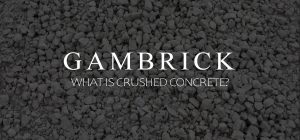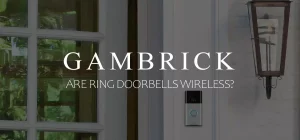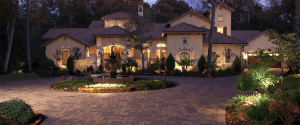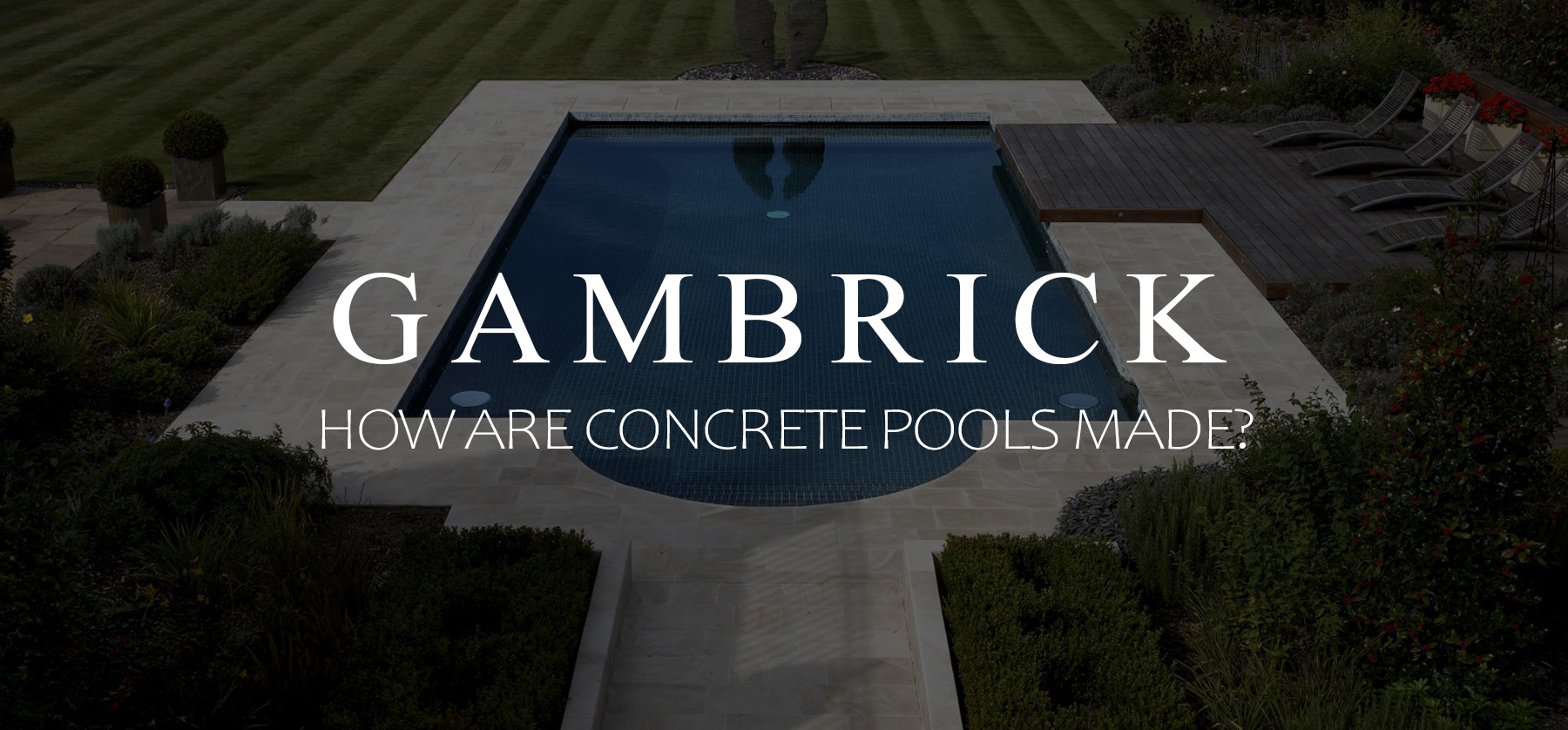
How Are Concrete Pools Made?
I’ve been a mason for over 25 years and can tell you firsthand, the best pools in the world are made out of reinforced solid concrete. They’re super strong, durable and custom built. Concrete pools are typically made by spraying either Gunite or Shotcrete (two forms of concrete) onto a steel rebar frame or by pouring solid concrete into forms, similar to how cast concrete statues, countertops, and foundation walls are built. Plumbing lines for filters, cleaners, drains and heaters are run through the concrete and electric is installed for pool lights. Once complete, the walls and floor are waterproofed and finished with smooth plaster, tile or stone.
Concrete pools can be insulated with rigid foam. Surrounding the pool is generally a coping and more concrete, stone, tile, brick, landscaping, or stamped concrete. I prefer using masonry around a pool because it’s gritty, which is less slippery than decking.
Building a concrete pool is fairly simple, but isn’t easy to do. The site is excavated first. Then we pour gravel and compact the ground. Next, rebar is bent and tied together to form the pool’s skeleton and rigid foam sheets are installed to insulate the pool. We then shoot either Gunite or Shotcrete onto the rebar. This step forms the pool’s floor and walls.
Gunite is a dry mix with water in the sprayer, whereas Shotcrete is already wet. Both methods produce the same quality pool.
The pool’s surfaces are formed by hand using floats and trowels. Once the concrete is smoothed, it cures for about 28 days. But after just a few days, the concrete is hard enough to walk on and apply finishes like plaster, tile or stone.
Finally, the pool is filled with water and enjoyed.
What Is A Concrete Pool?
Concrete pools are entirely made from concrete. Which is a mixture of cement, stone, sand and water. It’s the same concrete used to build the foundation of a home, a patio, driveway, sidewalk or footing. They have a steel rebar frame that forms the floor, walls and steps. Many include additional features like a spa, waterfall or sundeck.
Concrete pools don’t have a liner. Instead, finish materials like smooth cement, tile and stone are installed on top of the concrete once it hardens.
There are 3 types of concrete pools which are:
- Shotcrete is a wet mix of concrete that’s sprayed onto the pool’s rebar frame.
- Gunite is a dry mix of concrete that gets wet when it’s sprayed through the nozzle.
- Poured Concrete is poured into forms to create the pool walls instead of being sprayed onto rebar.
Gunite and Shotcrete are both forms of concrete that get shot out of a hose at high speed. It sticks to the rebar frame to form the floor and walls. As it’s applied and starts to dry, masons form the pool with floats and trowels.
Gunite and Shotcrete are both basically the same except Shotcrete is wet when it’s sprayed. Gunite is dry but mixes with water at the nozzle as it’s sprayed.
When making solid concrete pool walls, forms with rebar inside are built first and then filled with concrete. It’s the same basic process we use to build a poured concrete foundation.
Waterproofing membranes, finish coats, insulation, plumbing and electrical, heaters, filters, lights and skimmers are all added to the concrete pool at various times.
If your concrete pool cracks, repairs should be made immediately with a concrete crack filler.

How Concrete Pools Are Made
Most concrete pools are made with Gunite or Shotcrete concrete and not poured concrete. In this section that’s what we’ll be discussing. But if you’re interested in poured concrete pools scroll down to the next section.
It generally takes 3-6 months to design, build and start up a concrete pool. This includes initial designs, drawing up plans and obtaining building and zoning approvals. A concrete pool is a permanent structure so you can’t just build one wherever you want like you can with some liner pools.
Many concrete pools also come out of the ground which requires some additional engineering. The ground provides a lot of support for the pool, so when some of it comes out of the ground, that area needs reinforcing to prevent cracks.
Concrete pools are basically just solid concrete walls and a floor with rebar inside. Plumbing is run from the pool to mechanical equipment which clean, filter and heat the pool water. Electrical lines can also be installed to power underwater lighting.
Here’s a break down of the step by step pool construction process using Gunite or Shotcrete:
1. Concrete Pool Mark Out & Excavation
The first step is marking out the area where your concrete pool will be built. This is an important steps because many areas have strict zoning rules and you don’t want to build a pool in the wrong place.
Concrete pools are customizable, so you can design it in any shape you want. The classic rectangle pool design, called a Hamptons Style Pool, looks simple but elegant.
When preparing the site for your concrete pool, take into consideration the pool shape and depth along with the patio area, landscaping, hardscaping and filtration system.
It’s best to build your pool someplace flat to save money on drainage issues. Avoid building your pool too close to trees to prevent leaves from falling into the pool.
Excavating machines dig the area where the pool will be built. The ground can be dug by hand but machines do it much quicker. The hole for an average size 20×40 concrete pool can be dug in a day or two. The amount of time it takes can vary based on soil conditions, access to the area you pool is being built and weather.
You can have the excavator take the soil away from your property or use it for grading or other projects. There will be a lot of earth excavated, so have a plan for what to do with it before you start.
Pro Tip: You should always call for a utility mark-out before digging. All of your utility companies should come out to mark the underground lines. This includes cable, electrical plumbing and gas. I’d lo give a call to the sprinkler company so that lines and sprinkler heads can be routed around the pool.
2. Concrete Pool Plumbing Step 1
Rough plumbing is installed under the pool which will eventually become the pool drain.
Later in the job, more rough plumbing is installed through the pool walls. This is done after the rebar skeleton is built.
3. Base Material
Once the excavator is done and hole is dug, it’ usually cleaned up. Workers use shovels to clean out any loose dirt and rocks.
A few inches of gravel is usually spread on the ground and compacted. This creates a better base than dirt.
4. Steel Rebar
Steel rebar is cut, bent and tied together both vertically and horizontally. This includes all the pool walls, spas, steps and the floor. Rebar increases concrete’s strength and durability. Without rebar, the concrete would be prone to crack.
Concrete is very high in compressive strength, but low in tensile strength. Rebar makes up for this by adding tensile strength to the concrete. This gives the pool an ability to flex and move without cracking.
While concrete is very dense and difficult to crush, it’s vulnerable to cracks when it twists or bends. It’s a very rigid material with basically no flexibility. This is why concrete pool walls and floor have rebar inside. It ties the entire structure together and makes it much stronger.
Your concrete pool’s strength will also be determined by the amount of cement you use — the more cement you use, the more durable the concrete.
Usually cutting, bending and tying all the rebar together takes 2-3 days for an average size pool.
5. Concrete Pool Plumbing Step 2
Before any concrete is shot onto the rebar, rough plumbing lines are installed through the pool walls. The plumbing that extends through the walls is supported and held in place by the rebar.
All plumbing lines are capped and pressure tested before any concrete is shot. If the builder finds a leak it can be fixed while the pool is still open. Once the concrete is shot onto the rebar plumbing repairs become much harder to do.
A plumbing and steel inspection is usually done at this point before any concrete work is done.
Typically the rough plumbing takes 1-2 days to complete.
6. Concrete
Pool builders shoot either Gunite or Shotcrete concrete into place covering the entire rebar pool skeleton. Then they shape it using a variety of floats and trowels. This is the stage when the pool really comes to life and starts looking like a swimming pool.
From start to finish this stage take about 1-2 days. In day one, masons will have all the concrete shot and smoothed. In day two they’ll inspect the pool for flaws and make any necessary repairs. They’ll also check the concrete to make sure it’s begun curing properly.
7. Curing
Concrete goes through a process called curing, which is when concrete sets up, hardens, dries and grows stronger. As water evaporates out of the concrete, a chemical reaction occurs between the cement and water which forms a super strong crystalline structure. This is also called hydration. The entire process typically takes about 28 days to complete.
Concrete is not full strength once it initially hardens. Most pools are made out of 3500 – 4000 PSI concrete. Which actually means 3500 – 4000 Pounds Per Square Inch at 28 days of curing. After 2-3 days, the concrete pool will be safe to walk in and work on, but it’s only at about 1500 PSI.
Weather conditions affect how long it takes concrete pools to cure. If it’s damp or humid out, curing will take a little longer because there’s so much moisture in the air. However, if it’s extremely hot and sunny, concrete pools can cure too fast which can cause cracks To slow down the curing process, moisten the concrete surface and cover the pool with a plastic tarp.
Even though curing takes about 28 days to complete, masons should inspect the concrete every day for about 3 to 4 days after the pour to make sure the pool is curing properly.
8. Waterproofing
Concrete is super strong and dense, easily able to hold the weight of a full swimming pool worth of water, but it’s not waterproof. Concrete is a porous material that absorbs water. To make a concrete swimming pool waterproof, it has to go through waterproofing.
First the entire pool’s surface is inspected for imperfections. If any are found they need to be fixed before waterproofing is done. Once that’s complete, the concrete is scrubbed clean and dried. Then the inside walls and floor of the concrete pool are sprayed or rolled with a waterproofing material. This layer of waterproofing creates a barrier between the water and concrete.
Once waterproofing is done, the concrete pool becomes water tight.
It’s crucial to apply the waterproofing correctly. Concrete will absorb water because it’s very porous so you need to create a strong water resistant barrier. This keeps the pool water away from the structural concrete walls and floor.
9. Finish Work
There are a variety of finishes that can be applied to a concrete pool. My favorite is smooth white plaster. Have you ever seen a concrete pool in Greece? That’s the look I’m going for whenever we design or build a pool. Plaster can be applied to the floor and walls of the pool to create a smooth and durable surface.
Like concrete,plaster is porous and absorbs water, but it won’t get to the concrete because of the waterproofing layer.
Plaster is a mixture of cement, sand, marble dust, pigment, and water. It’s pumped through a hose and shot onto the concrete walls and floor. masons then smooth it using floats and trowels. By adjusting the pigment, you can achieve just about any color pool you want.
Concrete pools can stain at the waterline, so a 6 inch layer of tile can be installed at the top of the pool where the walls meet the coping. You could also tile the entire pool if that’s the look you like. Lots of pool have beautiful tile work including custom inlays.
Coping is the concrete or stone border placed around the perimeter of the pool on top of the walls. It’s installed after the walls of the pool are finished. Coping provides a transition from the pool to the patio.
Other finish work includes installing all the plumbing covers, lights, railings, diving board, slides, etc.
10. Pool Surround
Once the concrete pool is done it’s time to start finishing the rest of the yard. The area directly surrounding the pool is usually finished with either a deck, concrete, stone, brick or landscaping.
The area around the pool needs to be prepped in different ways depending on which finish method you choose. Decks need footings, concrete, stone and brick needs a compacted gravel or sand base and landscaping needs good soil.
11. Concrete Pool Start-Up
When all the construction is done it’s time to fill the pool with water and test out its mechanical systems.
The water chemistry will be set with either chemical additives like chlorine or salt.
Water chemistry should be checked and balanced every morning for about 2 weeks. Also brush the pool twice a day for about 10 days after filling to remove plaster dust from the surface.
Once all the plaster dust is removed and filtered out of the water, it’s safe to start heating the pool.
Generally it takes about 2 weeks to get the pool ready for swimming. Then it’s up to the homeowner or a pool company to check the water’s chemistry and monitor the water temperature.

Poured Concrete Vs Gunite & Shotcrete Concrete Pools
Concrete pools have a rebar skeleton with Gunite or Shotcrete concrete sprayed onto them. Once the concrete is applied, it’s smoothed by masons using floats and trowels. It’s a very artistic process because builders can form the concrete into whatever shape they want.
Poured concrete pools are a little different. Forms are built around the rebar skeleton just like the forms you’d use to build a poured concrete foundation. Then concrete is poured into the forms. Once it hardens, the forms are removed to expose the solid concrete walls. Then the walls are smoothed with a layer of cement called a brown coat. They’re waterproofed and finished with plaster and tile just like a sprayed concrete pool.
Poured concrete pools are great if the pool has all right angles. These pools are very Modern and sometimes called Hamptons Style. They’re very rectangular without any rounded or oval shapes.
When you build a poured concrete pool, the floor and footings have to be done first. The walls sit on top of the floor and footings.
Poured concrete pools are super strong and require less labor to finish so they cost a little less. But they’re just as strong and durable.
Luckily, the trend these days is rectangular and square shaped pools and a lot less angles so you can save money by using forms.
Poured concrete can be used along side shot concrete. This can be helpful if you have a mostly squared angle pool with a round spa or sun deck.
I like poured concrete pools because the walls can be insulated and waterproofed on the inside and outside of the pool.
What Type Of Forms Create A Poured Concrete Pool?
The forms used to build a poured concrete pool can be made from wood, metal or ICF (Insulated Concrete Forms).
Wood and metal forms are exactly the same forms you’d use to build the foundation of a house. They’re flat panels installed in a row and locked together. Then they’re reinforced with steel from the outside. Rebar is inside the forms and encased in concrete once it’s poured.
After the forms are removed, sheets of rigid foam can be installed to insulate the walls.
The reason why I love poured concrete pools is because they can be insulated and waterproofed on both sides. This is very difficult and not usually done with a Gunite or Shotcrete pool.
ICF forms are poured concrete forms that are insulated. Using ICF saves time because you don’t have to remove the concrete forms and then install insulation. The insulation is the form so steps are eliminated. This saves time and money.
If your building a square or rectangular concrete pool, I recommend looking into tradition poured walls or ICF. It gives you the opportunity to better insulate and waterproof the pool.
The Downside Of Poured Concrete Pools
No building technique is perfect, for all the benefits of using poured concrete to build a pool, there are a few disadvantages.
The biggest disadvantage to using poured concrete pool walls is excavation and back-fill In order to install the forms you have to dig a much bigger hole. This is because you’ll be working on both ends of the pool wall. Shot concrete only requires you to excavation to the edge of the pool because the earth contains the concrete.
With all that addition excavation comes back-fill. With a shot concrete pool you don’t have much back-fill because the concrete is shot right at the earth. However, with a poured concrete wall you have to back-fill all that dirt right up to the edge of the pool wall. This means more time and more work.
However, because you have all the area to work, it’s possible to waterproof and insulate the outside of the pool as well as installing gravel and drainage.
In my opinion, poured concrete pools are a better built concrete pool. They lack some of the artistic angles and customization of a shot concrete pool but make up for it with better drainage, insulation and waterproofing.
Poured concrete pools require forms which is a skill set unto itself. You need experienced masons that know how to build traditional forms or work with ICF. It’s not hard to find people like this but not all pool companies offer the service. What you need is more of a traditional mason and not a pool builder.
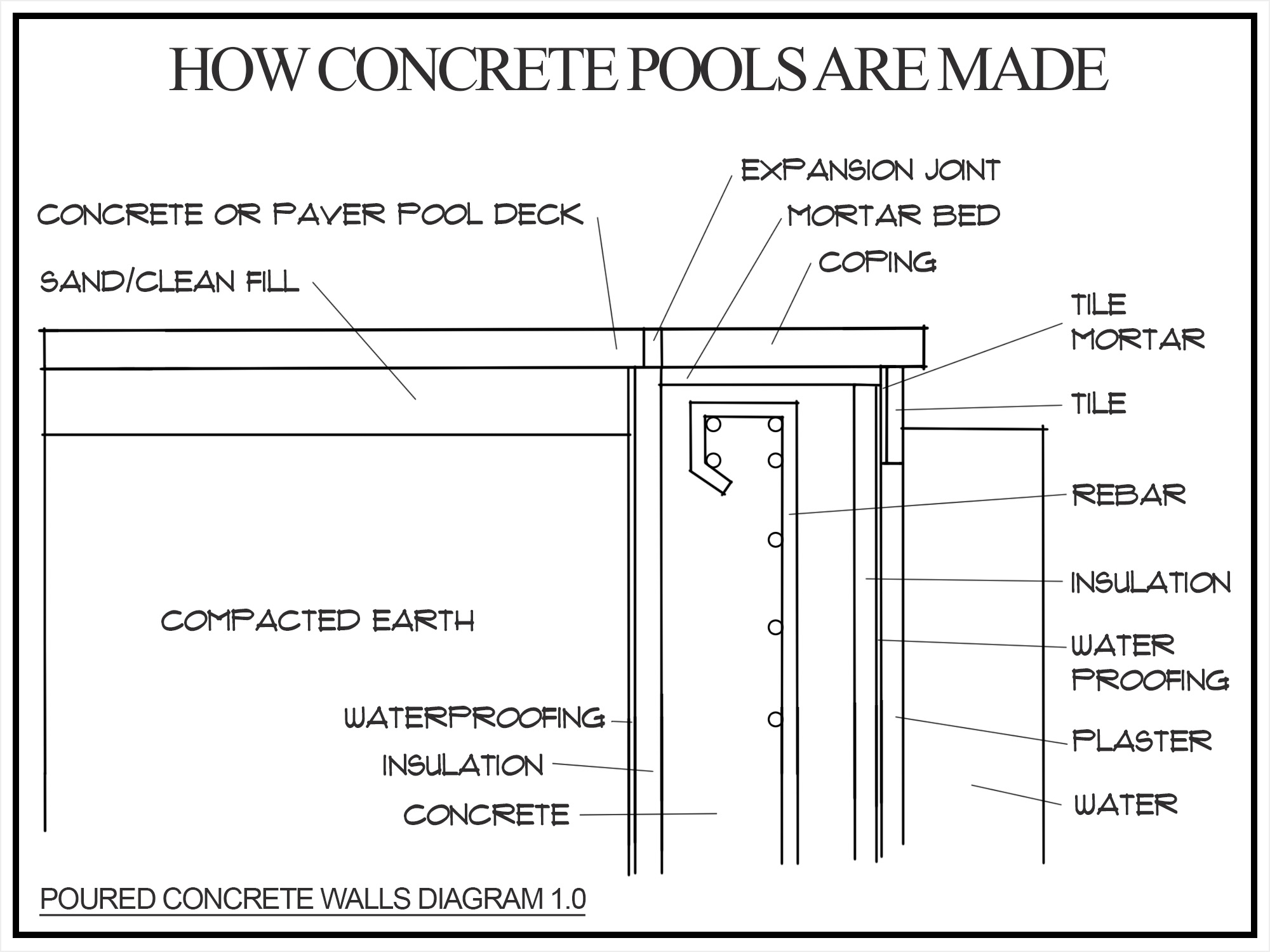
How Strong Is A Concrete Pool?
The strength of concrete is measured by its PSI (Pounds Per Square Inch). This is the amount of pressure per square inch it takes to break the concrete.
The average concrete used to build a concrete pool is 3500 – 4000 PSI. The same average strength a concrete driveway, patio, footing or foundation uses.
The PSI of concrete is controlled by the ingredients used to make it. Concrete is made by mixing cement, stone, sand and water. Cement is the active ingredient which reacts with water to form a paste that hardens and binds the entire mixture together. Sand gives concrete a gritty texture. Water activates the cement to start hydration and curing. But stone makes it strong. Stone is the ingredient that gives concrete such a high level of compressive strength.
There are two main ways to increase a concrete pool’s strength. Add more or larger stone to the concrete mix, use chemical additives, or both. But for the average size pool a standard 3500 – 4000 PSI mix is strong enough.
Concrete has a very low tensile strength which is why it cracks so easily when pulled or twisted. This can cause surface or structural cracks in a concrete pool. To compensate for this weakness, builders use a steel rebar frame to tie the concrete together and increase its tensile strength.
Using steel and concrete together creates a strong structure that’s also flexible enough to resist cracks.
How Thick Should A Concrete Pool Be?
There are multiple layers that make up the thickness of a concrete pool’s walls.
The walls of a concrete pool should be around 6 to 12 inches of solid concrete, depending on soil conditions and the design of the pool.
The pool’s plaster should be at least 1/2 inch thick. If you’re using tile at the waterline, the plaster should be flush with the face of the tile. Stone tile can be thick so you may end up with over an inch of plaster.
Concrete pools can also be insulated with rigid foam. This can add several inches to the pool walls thickness depending on how much R-value you want.
Waterproofing membranes can be added to the outside and inside of the pool walls. They’re typically very thin but can add 1/4″.
A concrete pool’s average strength is around 3500 – 4000 PSI. But despite its extreme strength and durability, concrete lacks tensile strength. This means it can easily crack when it moves. That’s why pool builders install rebar inside the concrete. It increases tensile strength and reduces the chance for cracks. But some cracks can still occur.
It’s very rare to get a structural crack in a concrete pool as long as they’re built correctly. But you can still get some small hairline cracks. This is usually caused when the concrete dries too quickly. Monitor the concrete as it cures and cover the pool if it gets too hot. Dampen the concrete surface to slow curing and reduce tiny surface cracks.
Small hairline cracks won’t leak water and will eventually be covered by plaster, but they should still be repaired before applying waterproofing and plaster.
When designed and built properly, a concrete pool should not crack. They’re extremely strong, durable and long lasting.
The Pros And Cons Of A Concrete Pool
Concrete pools are the best you can buy. They’re super strong, durable, beautiful to look at and totally customizable. But there are still a few downsides to building one.
Below we’ll go over the Pros vs Cons of a concrete pool.
Concrete Pool Advantages
There are a few big advantages to building a concrete pool compared with other types of pools like steel, liners and fiberglass.
Durability
Concrete pools are extremely durable. Poured concrete pools can have insulated walls as thick as a foot with steel rebar reinforcement. If built correctly, a concrete pool won’t crack or deteriorate.
Fiberglass pools are strong but can crack or be scratched much easier than concrete. Vinyl pools are very weak and easy to cut. In terms of strength and durability, nothing beats a solid concrete pool.
The plaster which makes up the inner finish of the pool is strong, but not nearly as strong as the concrete walls. But it’s still another layer of material that protects the pool.
Customization
Concrete pools are hand built on site and totally customizable.Unlike liners and fiberglass pools, you don;t have to choose from a predetermined size or shape. A concrete pool can be designed and built in any shape or size to fit the homeowners needs. This makes them 1 of a kind and very unique.
Another advantage is that you can customize the depth and slope of the pools floor any way you like including a sun deck.
A sun deck is an area of the pool that only has a few inches of water. They’re great for small kids or for pool chairs. Some fiberglass pools feature a sun deck but it’s not something you can get from a liner.
The finish of a concrete pool is another totally customizable feature. Use plaster, tile, or stone to create a near unlimited number or designs and color schemes.
Aesthetics
Concrete pools look much better than fiberglass or liner pools and are considered a “high end” pool. If you’re in the top end of the real estate market, you’ll want a concrete pool that fits the value of the home.
One of the great things about concrete pools is that you can match the style with the home and hardscaping. The home’s walkways, patios and landscaping can seamlessly flow with a concrete pool because it’s all customizable and hand made. Concrete pools are not products you buy out of a catalog and install, they’re built on site to fit the homeowners style.
Concrete pools have a classic pool appearance.If you’ve ever been to a nice hotel, a gym or swim club, the pools are almost always made from concrete. They’re the best type of pool you can buy and definitely look the nicest.
Concrete Pool Disadvantages
Timing
It takes a long time to design, plan and build a concrete pool. And once complete, you’ve got another few weeks of water testing, cleaning and filtering to do before you can actually use the pool. It’s usually about a 3 to 6 month process from start to finish.
Contrast this with liner and fiberglass pools that can be installed and used in under a month.
Rough Texture
The interior of a concrete pool is usually finished with plaster which is a type of rough cement. Most people don’t spend much time rubbing the sides or bottom of a pool but if you did it would feel rough.
However, if you want your pool to feel smooth, install tile on the walls and floor instead of plaster.
Maintenance
All pools require some maintenance, but it’s higher for concrete pools because of their rough and porous surface.
Because of how porous the plaster finish of a concrete pool can be, it’s easier for things like algae to grow. And once algae starts growing it’s hard to remove.
Stains are another problem. It’s much easier for substances to discolor porous plaster than it is smooth vinyl or fiberglass. In general, the smoother a surface that harder it is to stain because it’s harder for stains to stick.
Most concrete pools benefit from a good acid wash every 3-5 years. Acid washes are a great way to keep the plaster coat and tile clean and bright.
To prevent algae growth and stains, the entire surface of a concrete pool should be scrubbed about once a week. This is especially important around the water line.
Basic pool maintenance like this can be done yourself, but hiring a pool company is easier. Although it’s not cheap.
Chemicals
Because algae embeds into the plaster so easily, you have to regulate the chemicals more carefully than a fiberglass or liner pool. With concrete there’s less room for error.
Concrete is alkaline-based, which can increase the pH level of the pool water. You should counter this by adding acid to the pool as needed.
Regulating the pH balance of the pool and keeping it clean are very important. This requires more time and money. Especially if you have a pool company do it for you.
Long Term Costs
The plaster coat of a concrete pool generally needs some type of refinishing every 10-15 years. And the pool will probably need an acid wash every 3-5 years. Both of these jobs requires hiring a professional.
In the long term, concrete pools cost more money to own than fiberglass or vinyl liner pools.
The initial price and long term maintenance of a concrete pool is much higher than fiberglass or vinyl liner pools. But if you want the best, it’s usually the most expensive.
What’s The Average Cost Of A Concrete Pool?
On average, a 20′ x 40′ concrete pool with coping, plaster and 6″ of tile costs between $75,000-$100,000 depending on the region. This is all in including the design, permits, mechanical equipment, excavation, building the pool and the initial start up. But it’s not uncommon for concrete pools to cost much more. Especially when you start adding amenities like fire features, waterfalls, above grade areas, spas and sun decks.
Maintenance costs can easily average $2,000 to $5,000 per year if you hire a pool company to care for your concrete pool. This includes regulating water levels, basic cleanings and an acid wash every 3-5 years.
Resurfacing the plaster every 10-15 years costs around $5,000-$10,000.
These prices are just averages, you’ll have to adjust them based on the region you live in and the size and complexity of your pool design.
How Long Does It Take To Build A Concrete Pool?
The average concrete pool takes about 6 month to design and build which includes permits. But this can depending on where you live. In some areas like California it may take 6 months just to get zoning approvals.
Once designs and permits are issued, construction of the concrete pool usually takes 2-3 months. This is from excavation to the initial opening of the pool. But a concrete pool can take much longer depending on the size, design and finish.
If your concrete pool has a lot of custom tile work, fire features, waterfalls, a spa or sun deck, it can take much longer.
Many homeowners also include hadscaping, a deck or patio and landscaping with the pool. This will add even more time to the pool construction.
It’s not uncommon for a large scale pool project including hardscaping and landscaping to take a year to complete.
Can You Build Your Own Concrete Pool?
If you have experience working with poured concrete or block, then you can build your own concrete pool.
To build a DIY concrete pool you need a plan which you can buy from a pool designer architect or engineer. I wouldn’t try building a concrete pool by yourself without a blueprint. The plan will tell you how thick the walls and floor needs to be, where to place the rebar, what type of concrete to use, and layout the mechanical systems.
I’d hire a Pro for the electrical and plumbing parts of the job.
Most areas will need the pool plan and location to be approved before you start building.
Once you’ve got your plan and zoning approvals done you can start working.
If you’re building a concrete pool yourself I’d stick to poured concrete or cinder block walls. Stay away from Gunite or Shotcrete. If you’ve never done it before I wouldn’t start by building your own pool. It’s a skill that definitely takes some time to master.
Poured concrete and block are much easier to learn. Just follow the plan and these basic steps:
- Mark out and excavate
- Install the rebar and rough plumbing under the floor
- Pour the floor and footing concrete
- Build the forms or install cinder blocks and install more rough plumbing and electrical through the walls
- Pour concrete
- Remove forms or leave them in place if you used ICF
- Install insulation and vapor barriers
- Install tile, plaster and coping
- Back-fill and drainage
That’s basically it. You can build your own concrete pool if you’ve got the skills. And it can definitely save you money. Just make sure to hire a professional pool designer, architect or engineer to design the pool blueprint and mechanical system design. And always stick to the plan.
Why Are Concrete Pools More Expensive?
Concrete pools are more expensive than fiberglass and liner pools for a few reasons.
First, they’re the best pools money can buy. A concrete pool is completely custom and hand built on site. They’re not mass produced at a factory using a mold or assembled on site from a box of parts.
Concrete pools are much stronger than other types of pools. In some cases, the walls are a solid foot thick of concrete with steel rebar reinforcement inside. Fiberglass is strong too, but no where near concrete. And concrete pools are almost impossible to cut or crack like a fiberglass and liner pool are.
Concrete pools have to be finished after they’re built. Usually this includes some tile and plaster work. But it could also include a completely tiled pool with inlays or stone. Fiberglass and liner pools don’t need more finishing after they’re installed.
Materials are more expensive too. Concrete, plaster, tile, stone and rebar cost more than fiberglass or a liner pool kit. And they take a lot more labor to build.
Fiberglass and liner pools are assembled or installed, but concrete pools are built.
Long term maintenance costs more for a concrete pool too. The plaster generally needs resurfacing every 10-15 years and you should scrub the pool with an acid wash every 3-5.
Because of algae growth, concrete pools need to be cleaned more often than liner and fiberglass pools. They also require tighter regulation of Ph levels and more filtration to keep them clean.
How Long Do Concrete Pools Last?
When properly built, a concrete pool can easily last 50-100 years. The rebar and concrete structure should remain in good shape as long as the inner pool is maintained properly and the concrete is waterproofed.
The key to a long lasting concrete pool is maintenance. You can’t just build it, fill it with water and expect it to last forever. Concrete pools needs cleaning and repairs to maintain their plaster coat and waterproofing.
Summary: How Are Concrete Pools Made?
I’ve been a mason for over 25 years and can tell you firsthand, the best pools in the world are made out of reinforced solid concrete. They’re super strong, durable and custom built. Concrete pools are typically made by spraying either Gunite or Shotcrete (two forms of concrete) onto a steel rebar frame or by pouring solid concrete into forms, similar to how cast concrete statues, countertops, and foundation walls are built. Plumbing lines for filters, cleaners, drains and heaters are run through the concrete and electric is installed for pool lights. Once complete, the walls and floor are waterproofed and finished with smooth plaster, tile or stone.
Concrete pools can be insulated with rigid foam. Surrounding the pool is generally a coping and more concrete, stone, tile, brick, landscaping, or stamped concrete. I prefer using masonry around a pool because it’s gritty, which is less slippery than decking.
Building a concrete pool is fairly simple, but isn’t easy to do. The site is excavated first. Then we pour gravel and compact the ground. Next, rebar is bent and tied together to form the pool’s skeleton and rigid foam sheets are installed to insulate the pool. We then shoot either Gunite or Shotcrete onto the rebar. This step forms the pool’s floor and walls.
Gunite is a dry mix with water in the sprayer, whereas Shotcrete is already wet. Both methods produce the same quality pool.
The pool’s surfaces are formed by hand using floats and trowels. When the concrete is hard enough to walk on, finishes like plaster, tile or stone are applied.
Finally, the pool is filled with water and enjoyed.
If you have any questions about concrete pools, email or leave a comment below.

John Mazzuca | About | More Posts |
Custom Home Builder
John Mazzuca is a custom home designer and builder at Gambrick with over 25 years experience in the construction industry. John has designed, built and/or remodeled hundreds of homes, small buildings, and commercial projects. He writes about business, real estate, home building, and household electronics. His work has been featured in Fox Business, Better Homes & Garden, House Beautiful, and more.

